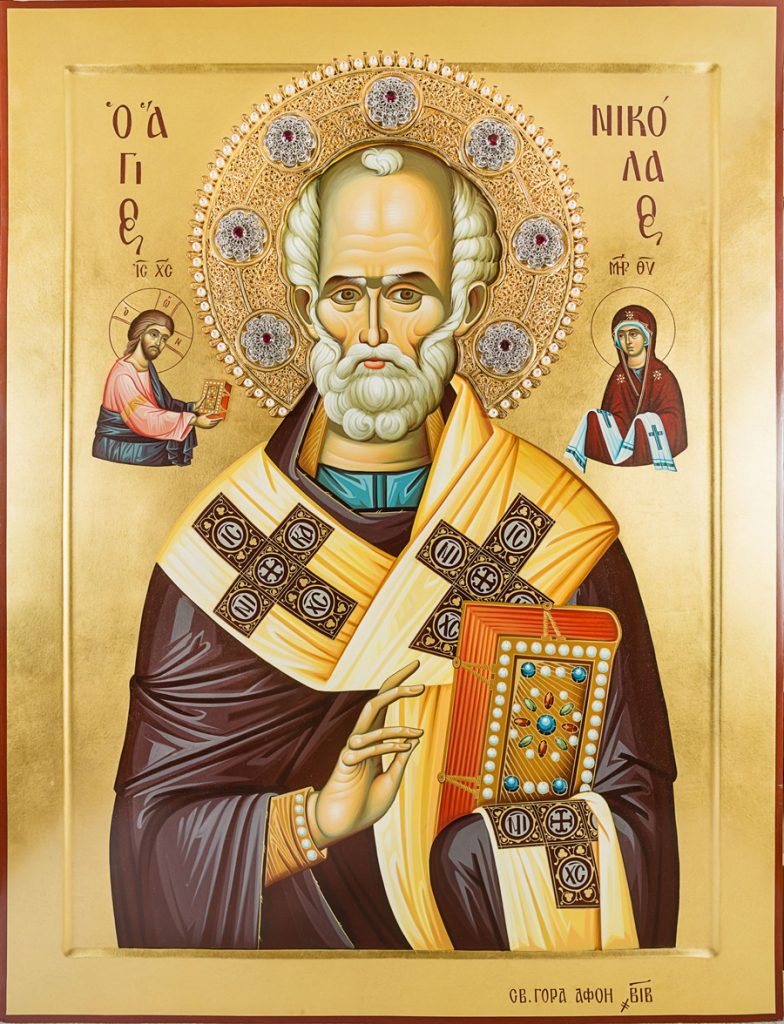 On the icons of St. Nicholas, the Lord Savior is usually depicted on one side with a Gospel in His hands and, on the other side, the Most Holy Virgin, the Theotokos, with an episcopal omophor on her hands. This has a two-fold historical significance, and in the first instance, this signifies the calling of Nicholas to the Hierarchical office and in the second instance, his justification from the punishment because of the confrontation with Arius.
On the icons of St. Nicholas, the Lord Savior is usually depicted on one side with a Gospel in His hands and, on the other side, the Most Holy Virgin, the Theotokos, with an episcopal omophor on her hands. This has a two-fold historical significance, and in the first instance, this signifies the calling of Nicholas to the Hierarchical office and in the second instance, his justification from the punishment because of the confrontation with Arius.
 St. Methodius, the Patriarch of Constantinople writes: “One night, St. Nicholas saw our Savior in glory standing by him and extending to him the Gospel, adorned with gold and pearls and, on the other side, he saw the Theotokos who was placing the episcopal pallium [omophorion] on his shoulders.” Shortly after this vision John, the Archbishop of Myra, died and St. Nicholas was appointed as archbishop of that city. That was the first incident. The second incident occurred at the time of the First Ecumenical Council in Nicaea. Unable to stop Arius of the irrational blasphemy of the Son of God and His Most Holy Mother by reason, St. Nicholas struck Arius on the face with his hand. The holy fathers at the Council, protesting such action banned Nicholas from the Council and deprived him of all his episcopal signs. That same night, several of the holy fathers saw an identical vision, namely, how the Lord Savior and the Most Holy Theotokos standing around St. Nicholas; on one side the Lord Savior with the Gospel and, on the other side, the Most Holy Theotokos with a pallium extending to the saint the marks of his episcopacy which had been removed from him. Seeing this, the fathers were awe-struck and quickly returned to Nicholas that which had been taken away and began to respect him as a great chosen one of God and his actions against Arius, they interpreted, not as an act of unreasonable anger, but rather an expression of great zeal for God’s truth.
St. Methodius, the Patriarch of Constantinople writes: “One night, St. Nicholas saw our Savior in glory standing by him and extending to him the Gospel, adorned with gold and pearls and, on the other side, he saw the Theotokos who was placing the episcopal pallium [omophorion] on his shoulders.” Shortly after this vision John, the Archbishop of Myra, died and St. Nicholas was appointed as archbishop of that city. That was the first incident. The second incident occurred at the time of the First Ecumenical Council in Nicaea. Unable to stop Arius of the irrational blasphemy of the Son of God and His Most Holy Mother by reason, St. Nicholas struck Arius on the face with his hand. The holy fathers at the Council, protesting such action banned Nicholas from the Council and deprived him of all his episcopal signs. That same night, several of the holy fathers saw an identical vision, namely, how the Lord Savior and the Most Holy Theotokos standing around St. Nicholas; on one side the Lord Savior with the Gospel and, on the other side, the Most Holy Theotokos with a pallium extending to the saint the marks of his episcopacy which had been removed from him. Seeing this, the fathers were awe-struck and quickly returned to Nicholas that which had been taken away and began to respect him as a great chosen one of God and his actions against Arius, they interpreted, not as an act of unreasonable anger, but rather an expression of great zeal for God’s truth.
Prolog of Ohrid By Bishop NIKOLAI VELIMIROVCH
